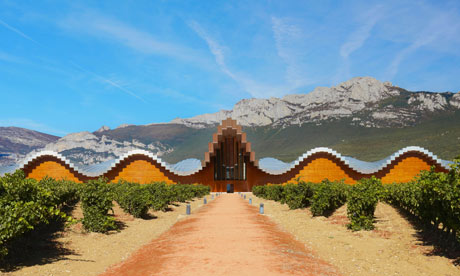He is the genius behind some of the world's most spectacular bridges, museums and airports, but Spanish architect Santiago Calatrava cannot plug a leaking roof, according to a client who is demanding he contribute to the €2m (£1.7m) needed to pay someone else to do the job. A dozen years after Calatrava built the spectacular Ysios winery in the rainy Alava region of northern Spain, the building's dramatic, undulating roof continues to let in the damp.
Now Domecq, the owner of the winery, has said it is fed up with the botched attempts of Calatrava's original builders at fixing the roof and wants money from them so that it can bring in fresh architects and engineers to design a new one.
An expert's report that accompanies a writ lodged at a court in Vitoria claims that the roof, made of wood and aluminium, has never managed to keep the rain out. The firm pledges to maintain the original outline designed by Calatrava – an architect and engineer sometimes compared with fellow Spaniard Antoni Gaudí – but says that the leaks are damaging its image.
The row comes on the top of complaints in Calatrava's home city of Valencia about the slowly wrinkling, ceramic outer skin of the city's emblematic Palau de Les Arts, where tiles have started to shake loose.
Opposition politicians in Valencia claim that the overall budget for his spaceship-like arts and science complex in the city has quadrupled to €1bn – with almost €100m for the architect's firm. They have demanded that Zurich-based Calatrava, who responded that "his honour was wounded", give some of the money back.
"It has not just put Valencia on the map, but is the second-most visited cultural centre in Spain, after the Alhambra," the architect once declared.
He is also on record as saying that his fees for various projects in the city were perfectly reasonable.
Yet another row, this time with Italian authorities, has seen doubts raised about the cost of his bridge over the Grand Canal in Venice – the first bridge to be built there in 75 years. Authorities now demand that he and others involved cover some €4m of spending, while Il Giornale newspaper recently claimed the city had received some 5,000 complaints from those who have used it, including some who also claim it is too slippery.
In northern Bilbao, meanwhile, his Zubizuri bridge over the river Nervión has been dubbed the "wipe-out" bridge, because of the number of people who have slipped and fallen. Authorities there have also reportedly had to spend up to €6,000 a year replacing broken tiles.
The mayor of Bilbao, Iñaki Azkuna, who lost a case against him after authorities altered the original design of his bridge, once declared: "I'm fed up with the dictatorship of Calatrava." In Oviedo a court has ordered that the architect and construction firms involved in building a conference hall there should pay €3m to the insurance firm after part of the structure collapsed during building.
The Oviedo hall's infamous, huge mechanical visor has never worked because of problems with its hydraulics. Calatrava is currently battling the building's owners through the courts after they blamed him and refused to pay his full fees.
But for every Calatrava building that gets into trouble, there are several that survive without creating polemic. They include two bridges in Dublin and Manchester, railway stations in Lisbon, Liege and Lyon and buildings in New York and Milwaukee.
Calatrava did not respond to questions sent to his Zurich office.
Related Stories
| Oct 5, 2011
GREENBUILD 2011: Johnson Controls announces Panoptix, a new approach to building efficiency
Panoptix combines latest technology, new business model and industry-leading expertise to make building efficiency easier and more accessible to a broader market.
| Oct 5, 2011
GREENBUILD 2011: Software an architectural game changer
Interactive modeling software transforms the designbuild process.
| Oct 5, 2011
GREENBUILD 2011: Tile manufacturer attains third-party certification for waste recycling processes
Crossville has joined with TOTO to recycle that company’s pre-consumer fired sanitary ware.
| Oct 5, 2011
GREENBUILD 2011: Sustainable construction should stress durability as well as energy efficiency
There is now a call for making enhanced resilience of a building’s structure to natural and man-made disasters the first consideration of a green building.
| Oct 5, 2011
GREENBUILD 2011: Solar PV canopy system expanded for architectural market
Turnkey systems create an aesthetic architectural power plant.
| Oct 5, 2011
GREENBUILD 2011: Kohler builds sustainable booth at Greenbuild 2011
In a setting composed of reclaimed materials, biodegradable signage, energy-efficient lighting and more, exhibitor highlights its new products with ecological awareness.
| Oct 5, 2011
GREENBUILD 2011: Brick offers growing options for sustainable building design
Brick exteriors, interiors and landscaping options can increase sustainability that also helps earn LEED certification.
| Oct 5, 2011
GREENBUILD 2011: Roof hatch designed for energy efficiency
The cover features a specially designed EPDM finger-type gasket that ensures a positive seal with the curb to reduce air permeability and ensure energy performance.
| Oct 4, 2011
GREENBUILD 2011
Click here for the latest news and products from Greenbuild 2011, Oct. 4-7, in Toronto.



















